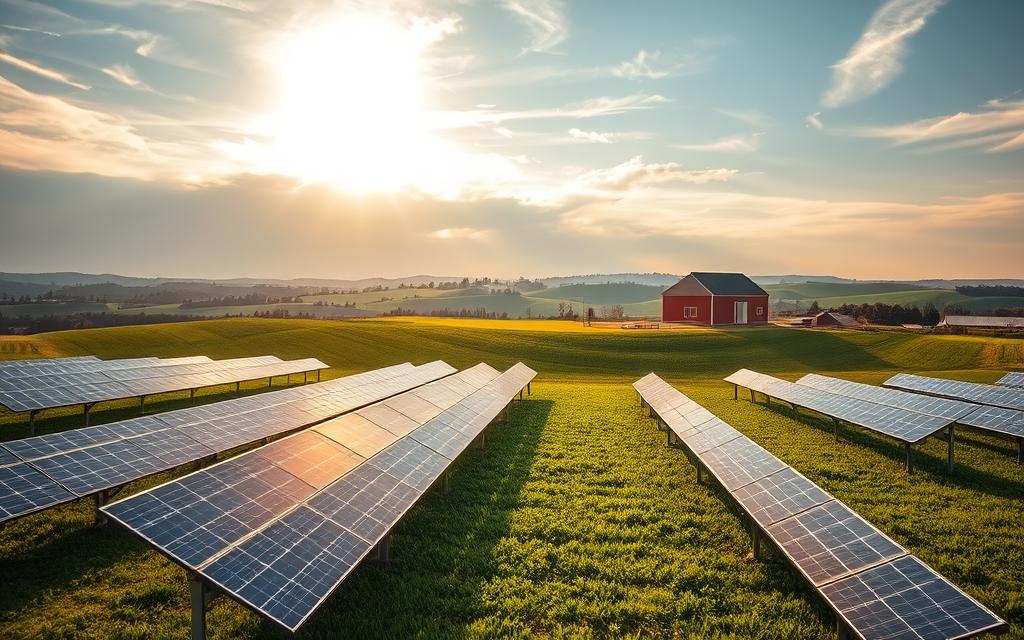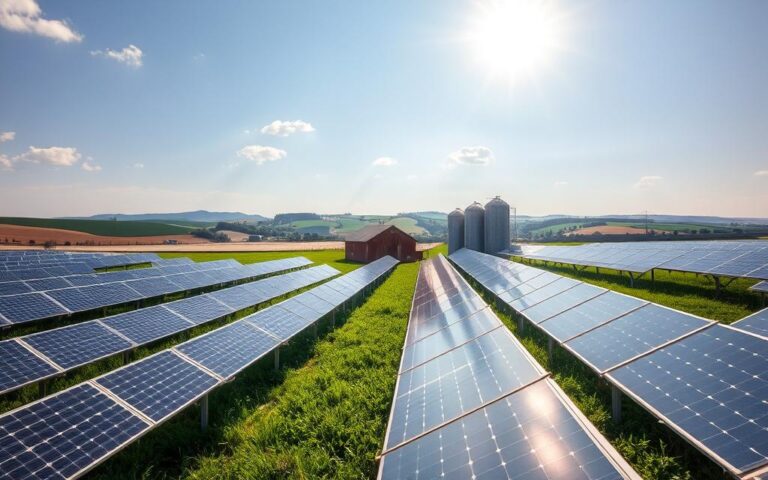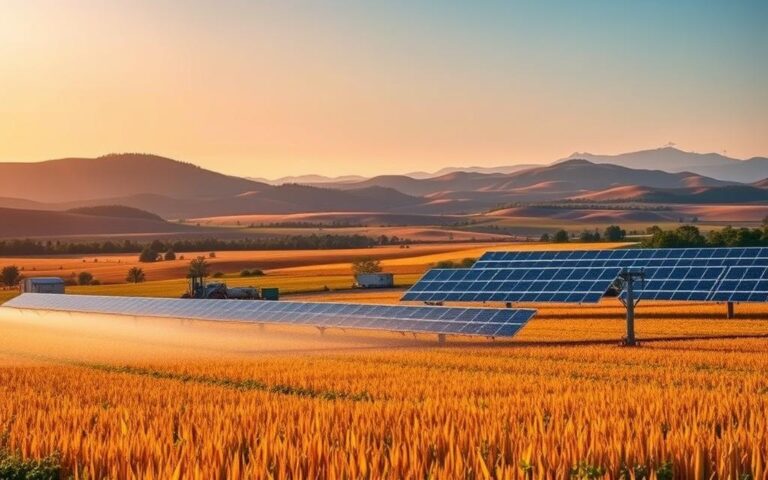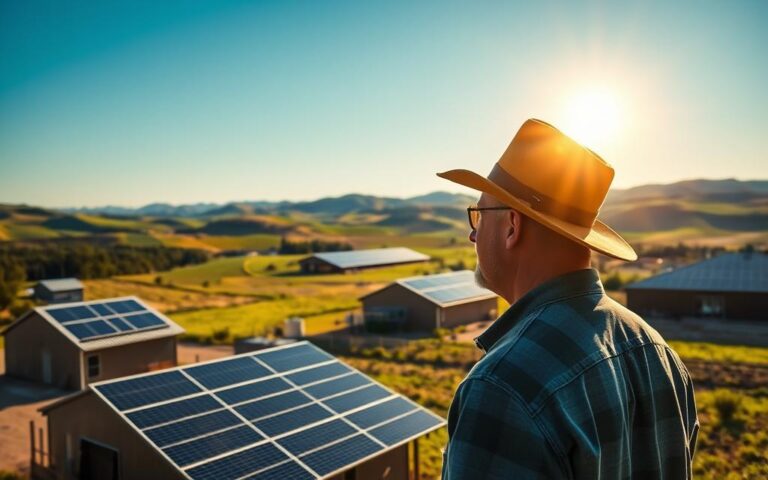Did you know solar energy could be 20% of U.S. farming’s total energy by 2050? The agricultural sector is turning to sustainable solutions, and solar panels are a key part of that. They save costs and help farms be better stewards of the environment.
Technology is improving, and governments are offering more support. This makes solar energy on farms a smart choice. It cuts down on energy costs and helps the environment. Solar panels in agriculture are a must for farms to thrive in the future.
Introduction to Solar Energy in Agriculture
Solar energy is becoming more popular in farming. Farmers want new ways to power their work and use less fossil fuel. With climate change getting worse, finding clean energy is key. Solar energy for farms is a good solution.
Solar tech can be used on many types of farms. It lets farmers use sunlight to make clean energy. This move to green energy for farms cuts costs and makes farming stronger.
By using solar energy, farmers help the planet and keep farming productive. They play a big part in moving to renewable energy.
But, there are worries about land use and farming practices. Farmers need to find ways to use solar energy without losing land. Still, the benefits of solar energy for farms are big. It leads to a greener and more innovative farming future.
The Benefits of Using Solar Panels on Farms
Using solar panels on farms brings many advantages. Farmers save a lot of money, get financial help, and enjoy long-term savings. These benefits make solar panels a smart choice for farms.
Reducing Operating Costs
Solar panels help farmers cut down their electricity bills. This means they save money every month. Over time, many farmers end up paying nothing for electricity.
Tax Incentives and Financial Benefits
There are tax breaks for using solar energy. The Solar Investment Tax Credit (ITC) gives farmers back 30% of their costs. This helps a lot right away. Plus, farmers can use bonus depreciation to lower their taxes even more.
Long-term Savings and Sustainability
Solar panels are a long-term investment in sustainability. They last 25 to 30 years, saving money for decades. By using solar energy, farmers avoid expensive energy costs and stay financially strong.
Understanding Agricultural Solar Panels
Agricultural solar panels are key for farms to use renewable energy. They come in fixed or movable types. Farmers put them on rooftops or on the ground, based on their needs.
Using solar panels helps farms save money on energy. It also helps the environment by using clean energy. This makes farming more sustainable and cost-effective.
Agrivoltaics is a new way to farm and make solar energy at the same time. It makes better use of land and keeps farming productive. This way, farms can grow crops and make energy together.
In short, solar panels are crucial for farms today. They help farms produce energy and grow crops efficiently. Moving to solar energy is a step towards a greener future for farming.
How Solar Panels Can Enhance Farm Productivity
Adding solar panels to farms is a new way to boost crop production. This method, called agrivoltaics, lets land serve two purposes. It can be used for energy and farming at the same time.
By putting up solar arrays, farmers can use their land more efficiently. They also get benefits from better microclimates and less water loss.
Agrivoltaics: Dual Use of Land
Agrivoltaics changes farming for the better, letting crops grow under solar panels. It makes land useful for two things. It also gives crops a cool, shaded spot during hot weather.
This approach helps farms stay strong against climate changes. It leads to better yields and smarter use of land.
Improving Crop Health and Soil Quality
Solar panels can make crops healthier and soil better. They offer shade, which helps plants avoid heat stress. This also cuts down on water loss, keeping soil moist.
With good management, agrivoltaics can make farms healthier. It helps a lot in making food production more sustainable.
Financing Options for Farm Solar Energy Systems
Farmers have many ways to pay for solar energy systems. This can help reduce the upfront costs. It’s important to know the costs and how much money you can save.
Understanding Initial Costs and Payback Period
Getting a solar energy system costs a lot. For example, a 100 kW system might cost between $200,000 to $300,000. The time it takes to get your money back is usually 5 to 10 years.
This depends on how much energy costs in your area and how well the system works. By looking closely at these numbers, farmers can see when they’ll start saving money.
Grants and Incentives for Farmers
There are many ways for farmers to get help with solar energy. The USDA has a program called REAP that gives grants to farmers. This can cover a big part of the cost.
States also offer extra help. They have incentives that can make solar energy even more affordable. Here’s a table showing what grants and incentives are available in different states:
| State | Grant Amount (REAP) | Additional Incentives |
|---|---|---|
| California | Up to $500,000 | California Solar Initiative: $1,000/kW |
| Texas | Up to $250,000 | Solar Property Tax Exemption |
| New York | Up to $1 million | NY-Sun Incentive Program: $0.60/W |
| Florida | Up to $250,000 | Florida Solar Energy Incentive Program |
These financing options make solar energy for farms possible. They also help farms be more sustainable. Talking to local offices or energy co-ops can help farmers find and use these resources.
Installing On-Farm Solar Installations
Farmers have to think about several important things when they want to install solar panels on their land. They need to figure out how much energy they use, how much they can spend, and how much space they have. These steps help make sure the solar panels work well and bring good returns.
Choosing the Right Solar System
Choosing the right solar system starts with knowing how much energy the farm needs. Farmers should think about how much electricity they use and how solar can save them money. They should look at different solar panels and inverters to find the best one for their needs.
They also need to think about where to put the panels. The best spots are where the sun shines the most and the land is right for it.
Working with Qualified Installers
Working with skilled solar installers is key for a good solar installation. These experts make sure the system works well and meets all the rules. They help avoid expensive mistakes.
Farmers should look for installers who are licensed and offer full service. This includes checking the site, installing the panels, and taking care of them later. Choosing the right installer is important for the system’s long-term success.
The Role of Rural Solar Power in Sustainable Farming
Rural solar power is key to making farming more sustainable. It helps farmers use less fossil fuel, which cuts down on harmful emissions. This change is good for the planet and makes farming more profitable.
Using solar power in farming makes it stronger against climate change. Solar energy powers things like irrigation and farm equipment. This saves money, letting farmers invest in greener ways to farm.
Community solar projects boost sustainable farming even more. They bring farmers together, sharing solar power and energy independence. This builds a stronger local economy and promotes a green way of life in rural areas.
In the end, rural solar power is crucial for sustainable farming. It offers clean energy, keeping farms productive and eco-friendly. By embracing renewable energy, farming can help create a greener future.
Challenges and Considerations for Solar Energy in Agriculture
Using solar technology in farming comes with its own set of challenges. These systems need a lot of land, which can conflict with farming. It’s important to find a balance between making energy and growing crops.
Land Use and Competing Agricultural Needs
Farmers have to choose between using their land for solar panels or for crops. Solar panels can help with energy, but they take up space that could be used for farming. A solution could be agrivoltaics, where solar panels and crops share the same space.
Understanding Local Regulations and Restrictions
Following local rules is key for solar projects on farms. Farmers need to know about laws at the local, state, and federal levels. Knowing these rules helps solar projects fit in with zoning laws and protect the environment.
Maintaining Agricultural Solar Energy Systems
Regular solar system maintenance is key to keeping agricultural solar energy systems running well. Clean solar panels soak up more sunlight, boosting energy output. A simple cleaning routine with basic tools keeps panels dust-free.
It’s crucial to watch out for issues that might slow down performance. Regular checks can spot problems like broken panels, corroded wires, or faulty connections. Fixing these issues quickly can avoid expensive repairs later.
Warranty protection is vital for keeping agricultural solar energy systems in top shape. Many makers offer long warranties for parts and performance. Knowing your warranty details helps ensure your system works its best.
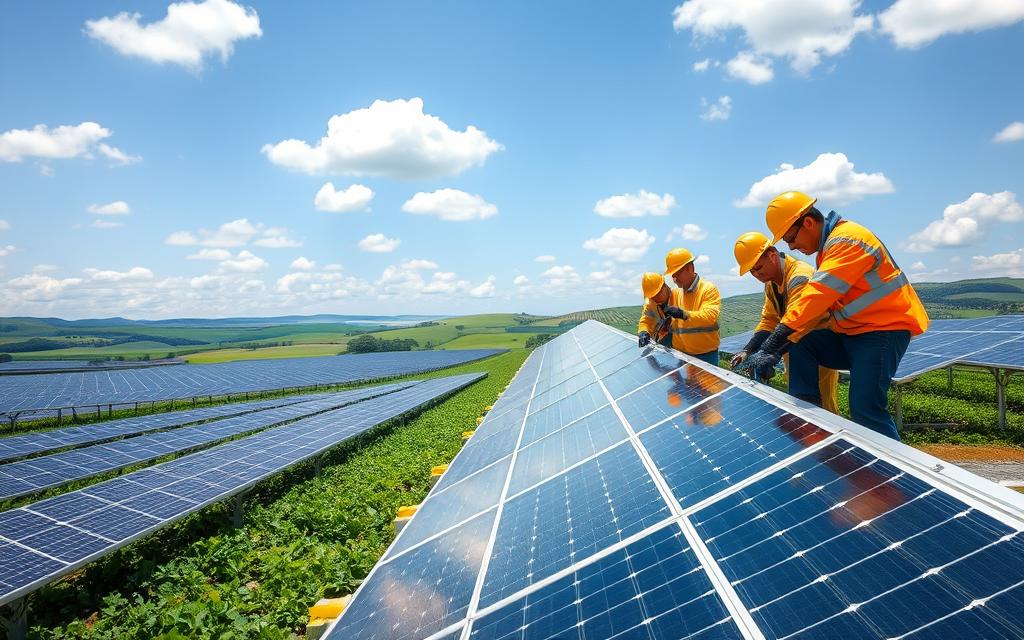
Future Trends in Solar Technology for Farms
The world of solar technology is changing fast. New innovations in solar panels could greatly change how farms use solar energy. These new technologies help make solar energy more efficient and meet the energy needs of farms.
Innovations in Solar Panel Efficiency
New materials and designs are being developed to catch more sunlight. Bifacial solar panels, for instance, grab sunlight from both sides. This means they can make more energy without taking up more space. These innovations in solar panels could make solar energy even more appealing to farmers.
Energy Storage Solutions
As more farms switch to solar, they need good storage systems. Better storage lets farmers use extra energy when it’s made during sunny times. This way, they can have energy even when it’s cloudy or at night. This is key for the future of farm solar energy, making sure farmers always have power.
| Innovation | Description | Impact on Farm Solar Energy |
|---|---|---|
| Bifacial Solar Panels | Panels that capture sunlight on both sides | Increases energy capture and efficiency |
| Advanced Energy Storage | High-capacity storage systems | Ensures energy availability during non-generating hours |
| Smart Energy Management Systems | Technologies that optimize energy use | Reduces waste and enhances system efficiency |
Policy Recommendations for Supporting Solar Growth in Agriculture
The growth of solar energy in agriculture needs a solid plan. This plan should support sustainable farming and protect land. Good policies help solar energy grow while keeping farms productive. It’s key to use renewable energy without harming the environment.
Smart Solar Initiatives and Land Conservation
Smart solar projects blend well with farming. They use land in ways that help farming too. This approach is crucial for keeping farms productive while adding solar energy.
Community Engagement and Stakeholder Involvement
Getting the community involved is essential for solar projects. Farmers, local governments, and others should work together. This way, solar energy meets economic and environmental goals, making it more accepted and lasting.
Case Studies of Successful Solar Implementation on Farms
Looking at real examples of solar farms shows how much farms can gain from solar energy. These stories show how farms have cut costs, used less energy, and become more sustainable.
In California, a vineyard set up a big solar array. This move greatly lowered their electricity bills. It also helped them stay green by using solar power for irrigation, cutting down on carbon emissions.
In Wisconsin, a dairy farm put solar panels on its barns. This move saved them a lot on electricity. They also got help from the state, making solar energy more affordable. This farm is now a role model for others, showing solar’s potential.

These examples prove solar energy is more than a trend for farms. They show the benefits of going solar, both for the wallet and the planet. This encourages more farms to follow suit.
Conclusion
Agricultural solar panels offer a big chance for farmers to cut costs and make their farms more sustainable. Using solar energy helps farmers save money and grow more food. It also helps the planet.
Switching to solar energy in farming has its challenges, like dealing with rules and finding space. But, the benefits last longer than the problems. Farmers should think about how solar panels can help their farms grow stronger and greener.
The move to solar energy in farming is not just a trend. It’s a key step towards better, greener farming. With the right help, farmers can use solar energy to make their farms better for the future.

